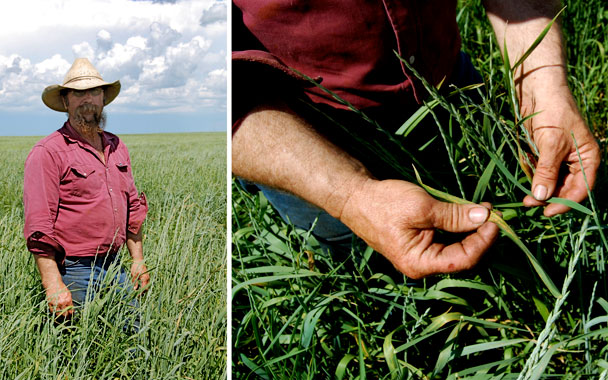Well, my confidence that the rage of extreme weather had passed didn’t last long. Temperatures barely reached the mid-80s last week in the South Dakota farm belt, but thunderstorms ripped through Walworth County, dumping two-inch hail on farms along the Missouri River. Surely it has to end soon. Surely some measure of psychic relief is just around the corner. The soybean harvest is only three weeks away, the corn harvest close on its heels.
Jim Lutter takes his cell phone out of his pocket, fingers the keypad, and then asks, “When is the September full moon?” His wife volunteers, “...on the 15th.” He looks straight at me and says, “I’ll bet you the biggest steak at your favorite restaurant that we’ll have a killer frost before September the 15th.” Frost! I’m just getting used to the hailstorms and tornadoes. It’s late August, and the limits of the growing season are beginning to crowd in. “We’ve already had some nights in the low 40s. If we get a frost in the next two weeks, we won’t get any beans,” Lutter says. His judgment is apocalyptic. His tone is matter-of-fact. He starts counting the accumulated “heat units” of the summer. “Late start in April. Cold and wet in the spring. We didn’t have hardly a day all summer over a hundred degrees. We got a lot of rain this year, but the rain cools off the day. Full moon September 15th. If we don’t get a frost before then, we’ll just barely make it to harvest.” Just barely make it... I think to myself. This isn’t farming. This is brinksmanship.
A month from harvest, the corn looks great. Seven feet tall. The proud king of the land. South Dakota farmers are on the verge of bin-buster yields. But the ecosystem is exhausted. Crop roots have sucked the last rains from soil reservoirs, and the soil is tired of the stress. Professional agronomists had measured and calculated fertilizer inputs with precision at the beginning of the season to boost artificial fertility, but nobody has calculated the beating that the soil’s biological diversity has taken over the last four months. Nobody knows how to begin to replenish the soil, except to offer rest, and that prescription pits the long-term viability of the land squarely against this year’s crops. “We don’t even know 80 percent of the species in the soil, and we don’t really know how the soil works. We don’t know the complexities of the food web in the soil,” says Tom Schumacher, a soil scientist at South Dakota State University. “We’re flying blind. We know that the soil system plays an essential role in the health of crops, and we know that it hasn’t collapsed yet. But it’s like Da Vinci said, ‘We know more about the celestial movements of the stars than we know about the soil.’ ”
The logic of industrial agriculture pushes farmers toward ever-increasing applications of fertilizer and pesticides, even as the crops get closer to harvest, but there is also a countervailing law of diminishing returns, especially with the costs of petrochemical inputs going through the roof. Expensive inputs can’t hold off a killer frost, or lengthen the late-summer day. The irony of the moment is that monoculture crops need more heat, longer days, more pest control against hot-spot outbreaks, but the land needs a killer frost—nature’s way of saying “enough already” to the profligate growth of summer and the assault of chemical inputs.
Everyone is looking for a way to just get through the next 45 days.
Charlie Johnson has been hand-cutting weeds on his organic farm for two solid months. A hundred acres to go. Last week, chopping weeds in his soybean fields, his pant legs were thick with the sticky ooze created by an infestation of aphids. Aphids inject a toxin into the soybean leaf, then suck out the nutrients. “It’s like they are bleeding the plant,” Charlie says. These are the moments that test the convictions of an organic farmer—the urge to just nuke everything and get one good night’s sleep.
Aphids can reproduce in three days. A farmer who finds 20 aphids on a leaf on Monday finds 100 on Wednesday, 1,000 on Friday, and a dead plant a week later. The frantic speed at which aphids can take out a soybean field is the best advertising for hard-core chemical pesticides. The sheer terror of aphids makes most farmers flinch, but Charlie and his brother Allan don’t give in. “Aphids don’t have a pancreas. They can’t metabolize sugar,” Charlie explains. “So we went to the store and bought 100 pounds of sugar, mixed it with water, and sprayed it on the fields.” Sugar water. The mainstream chemical guys scoff. But a week later Charlie can’t find any aphids in his field, and his pant legs are “ooze free.” He’s not trying to kill every aphid in Lake County for the next ten years. He’s just trying to get to harvest and first frost. So far it’s working.




 Pinterest
Pinterest


